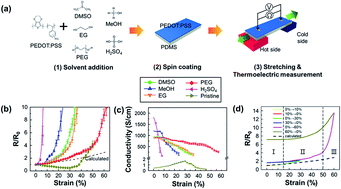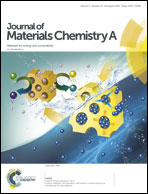Increasing the thermoelectric power factor of solvent-treated PEDOT:PSS thin films on PDMS by stretching†
Abstract
Poly(3,4-ethylenedioxythiophene)-poly(styrenesulfonate) (PEDOT:PSS) is one of the most promising candidate materials for flexible thermoelectric generators. We report changes in morphological, electrical, and thermoelectric properties of strained PEDOT:PSS thin films treated with solvents, including H2SO4, MeOH, and polyethylene glycol (PEG). The stretching creates macroscopic cracks on the thin film surface and microscopically change the domain structure from a dense network to an isolated state. With increasing strain, short, fine cracks at small strains propagate into long, thick cracks. The H2SO4 treatment makes PEDOT:PSS very brittle even at ∼5% strain, whereas PEG improves the stretchability of PEDOT:PSS up to 50%. Stretching reduces the electrical conductivity of solvent-treated samples, which agrees well with the decreased hole concentration of strained PEDOT:PSS, as confirmed by ultraviolet photoemission spectroscopy. In contrast, the Seebeck coefficient (S) of the strained PEDOT:PSS thin films increases. The PEG sample shows the highest S, and thus exhibits an enhanced power factor (PF) with strain, while other solvent treatments reduce PF. To the best of our knowledge, this is the first report on the strain-induced enhancement of S and thermoelectric PF of PEDOT:PSS.



 Please wait while we load your content...
Please wait while we load your content...